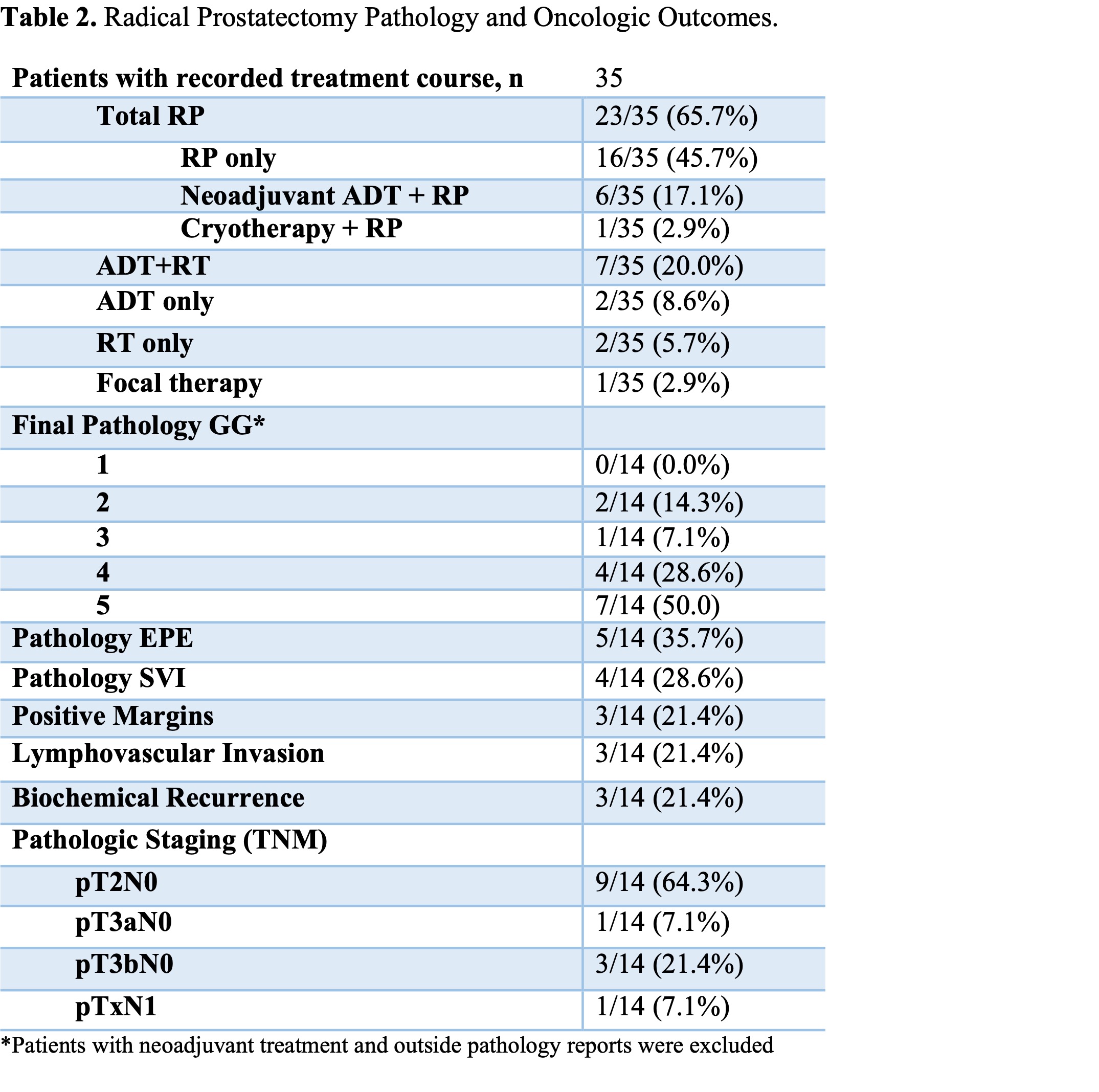Back
Introduction: Signet ring cells (SRC) on pathology are typically associated with gastric carcinoma, but are also rarely seen in other malignancies, including prostate cancer (PCa). Though primary SRC adenocarcinoma of the prostate is a well-described aggressive malignancy, there is a paucity of literature describing the oncologic significance of SRC on prostate biopsy in patients with primary acinar adenocarcinoma. In this study, we aimed to describe the clinicopathologic characteristics and outcomes of these patients.
Methods: A prospectively collected database of patients with PCa was queried for presence of SRC on prostate biopsy. Patients with primary SRC adenocarcinoma were excluded. Demographics, imaging, pathological and treatment data were collected. Patients who received radical prostatectomy (RP) without neoadjuvant therapy were examined for adverse features, including extraprostatic extension (EPE), seminal vesicle invasion (SVI), lymphovascular invasion (LVI), as well as post-RP biochemical recurrence (BCR).
Results: Between 2014-2022, 46 patients with SRC on biopsy were found. Clinicopathologic data is displayed in Table 1. Patients had a mean of 2.2 cores with SRC on biopsy, and 40/46 (87.0%) of these cores were GG =4. Oncologic outcomes are shown in Table 2. Every lesion containing SRC was MRI-visible, 93.3% of which were PIRADS 4 or 5. Of 14 patients with available whole-mount pathology data after RP, 12/14 (85.7%) had Gleason grade group = 3 disease. 5/14 (35.7%) patients had EPE, 4/14 (28.6%) had SVI, and 3/14 (21.4%) had LVI. 3/14 (21.4%) patients experienced BCR post-RP, with a median time to BCR of 12 months (3-28).
Conclusions: Signet ring cells on biopsy were typically identified in the setting of MRI-visible high-grade acinar adenocarcinoma and frequently associated with adverse features on whole mount pathology. While the biological significance of signet ring features in prostate cancer remains to be elucidated, clinical and pathologic correlates suggest an association with high risk disease and should prompt further study of this entity. SOURCE OF
Funding: N/A


Moderated Poster Session
Session: MP11: Prostate Cancer: Advanced (including Drug Therapy) I
MP11-17: Signet ring cells on prostate biopsy in the setting of primary acinar adenocarcinoma
Friday, April 28, 2023
9:30 AM – 11:30 AM CST
Location: S504
- DN
Poster Presenter(s)
Introduction: Signet ring cells (SRC) on pathology are typically associated with gastric carcinoma, but are also rarely seen in other malignancies, including prostate cancer (PCa). Though primary SRC adenocarcinoma of the prostate is a well-described aggressive malignancy, there is a paucity of literature describing the oncologic significance of SRC on prostate biopsy in patients with primary acinar adenocarcinoma. In this study, we aimed to describe the clinicopathologic characteristics and outcomes of these patients.
Methods: A prospectively collected database of patients with PCa was queried for presence of SRC on prostate biopsy. Patients with primary SRC adenocarcinoma were excluded. Demographics, imaging, pathological and treatment data were collected. Patients who received radical prostatectomy (RP) without neoadjuvant therapy were examined for adverse features, including extraprostatic extension (EPE), seminal vesicle invasion (SVI), lymphovascular invasion (LVI), as well as post-RP biochemical recurrence (BCR).
Results: Between 2014-2022, 46 patients with SRC on biopsy were found. Clinicopathologic data is displayed in Table 1. Patients had a mean of 2.2 cores with SRC on biopsy, and 40/46 (87.0%) of these cores were GG =4. Oncologic outcomes are shown in Table 2. Every lesion containing SRC was MRI-visible, 93.3% of which were PIRADS 4 or 5. Of 14 patients with available whole-mount pathology data after RP, 12/14 (85.7%) had Gleason grade group = 3 disease. 5/14 (35.7%) patients had EPE, 4/14 (28.6%) had SVI, and 3/14 (21.4%) had LVI. 3/14 (21.4%) patients experienced BCR post-RP, with a median time to BCR of 12 months (3-28).
Conclusions: Signet ring cells on biopsy were typically identified in the setting of MRI-visible high-grade acinar adenocarcinoma and frequently associated with adverse features on whole mount pathology. While the biological significance of signet ring features in prostate cancer remains to be elucidated, clinical and pathologic correlates suggest an association with high risk disease and should prompt further study of this entity. SOURCE OF
Funding: N/A


